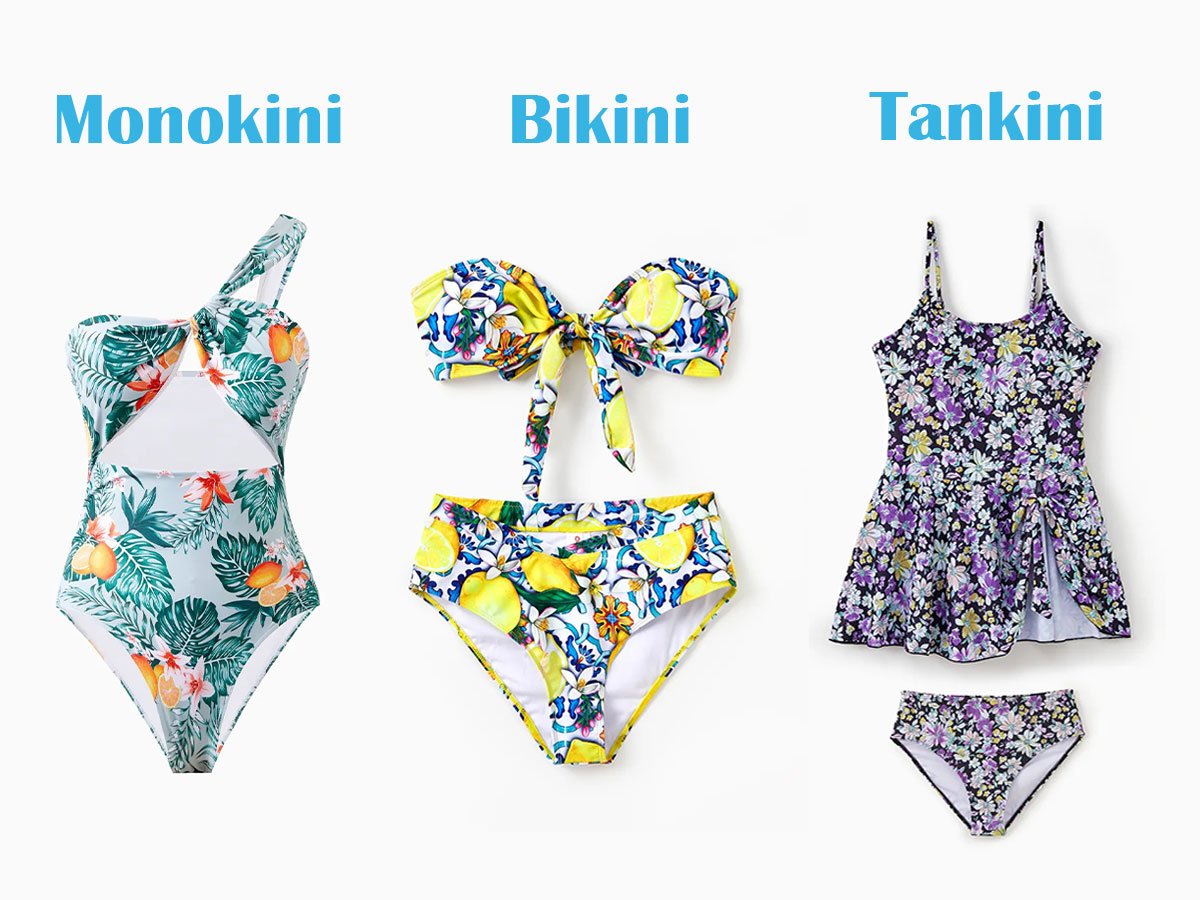Which swimsuit style is right for you? With so many choices, selecting the ideal swimsuit can feel taxing. Before deciding on swimwear for your beach trip or time by the pool or sun tanning adventure you must choose the appropriate clothing style. The swimsuit market provides various designs yet people choose to wear monokinis and tankinis in addition to bikinis the most frequently.
Every style serves a particular body type, fashion taste, and comfort level, providing unique advantages. The variations in different swimsuit designs, their benefits and drawbacks, and how to decide which one best fits your needs will be discussed in this post.
Understanding the Three Swimsuit Styles
1. The Bikini: The Classic Two-Piece

People have worn bikinis as symbolic fashion choices that combine self-assurance with attractiveness and liberty since the 1940s. Due to their two-piece design bikinis provide one of the most versatile swimwear options that permit female fashion expression during both comfort and functional activities. The bikini underwent multiple modifications which led to its evolution to fit various bodies during different occasions. Bikinis provide something for everyone, whether your style is beach volleyball’s sporty or lazing by the pool calls for a bright, elegant outfit.
Features of a Bikini:
Two-Piece Design
A bikini’s separate top and bottom allow you to mix and match several designs and colours. This simplifies designing a customized appearance that fits your body type and style.
Variety of Top Styles
Many top designs for bikinis include triangles, bandeau, halters, underwires, and ballet. Whether your desired cleavage is improved, better lift is sought, or a more relaxed fit, these designs meet varying support requirements.
Diverse Bottom Styles
The bottoms are equally varied from high-waisted for a throwback vibe to cheeky, thong, Brazilian, and traditional full-coverage styles. You might choose a cut that accentuates your curves or offers more subdued coverage.
Designed to Highlight Curves
Beautiful bikinis emphasize natural body lines, therefore enhancing confidence and fashion appeal. Certain designs call for ruching, knots, or adjustable straps to improve fit even more.
Pros of Bikinis:
Variety
Bikinis provide a great range to fit various personalities and fashion trends with unlimited designs, colors, patterns, and decorations.
Mix and Match
Bikinis allow you to mix tops and bottoms, offering countless clothing options, unlike one-piece swimsuits. A strong printed top with a solid bottom or vice versa will change your appearance.
Tanning-Friendly
Because minimal fabric coverage results in less tan lines, bikinis are an excellent choice for sun worshippers. While string bikinis minimize fabric interference, a bandeau bikini removes shoulder strap lines if you love an even tan.
Confidence Booster
Wearing a bikini can be a transforming event. Celebrating many forms and sizes helps one to embrace body positivity. Many women discover that the correct bikini makes them feel attractive, sensual, and trendy and boosts their confidence.
Cons of Bikinis:
Minimal Coverage
A bikini might not be your first choice if you want greater modesty.
Support Issues
Some forms are inappropriate for high-impact aquatic sports since they lack bust support.
Fit Concerns
Finding a great fit for the top and bottom can be challenging since they are separate components.
Click here to read :
2. The Tankini: The Perfect Combining of Worlds

Those who want style together with utility can choose a tankini which combines one-piece and bikini swimsuit parts. The tankini gives users convenience like two-piece swimsuit while providing more coverage than bikinis do. This swimwear combination offers both comfort and flexibility while maintaining fashionable appeal during relaxation by pools or in oceanic activities or during beach-related family movement.
Features of a Tankini:
It consists of a tank-style top and separate bottoms
Though it seems more modest, the tankini provides the flexibility of a two-piece outfit.
Offers different top designs
Loose-flowing, form-fitting, ruched, and peplum designs are among the several ways tankini tops are presented. This makes it simple to identify one that accentuates your natural shape and flatters your body type.
Provides varying lengths
While some tankini tops crop, others stretch further to mimic a one-piece swimsuit, covering more of the midriff. Built-in bras and adjustable straps provide further support and personalizing.
Bottoms range from full-coverage shorts to standard bikini briefs
Pair a tankini top with boy shorts, high-waisted briefs, or traditional bikini cuts from various bottoms to create a customized fit.
Pros of Tankinis:
More Coverage
For people who want to keep their stomach covered yet still value the utility of a two-piece swimsuit. This is a confident-boosting decision since the longer top helps hide the tummy.
Comfortable Fit
Swimmers can find safety and freedom of movement with the longer tankini during beach volleyball and water aerobics together with pool activities. A tankini offers better stability during use since it stays securely in position compared to moving and riding-up bikinis.
Easy Bathroom Breaks
The difficulty of having to remove the whole one-piece swimsuit when using the loo is one of its main negatives. A tankini eliminates this issue and speeds restroom breaks by providing the ease of a separate top and bottom.
Versatile for All Body Types
A tankini works to accentuate all body types, regardless of your frame—curvy, athletic, or petite. While pregnant women find tankinis a comfy and fashionable maternity swimsuit choice, plus-size women adore the added coverage. A few designs also have tummy-control panels for extra support.
Cons of Tankinis:
More Fabric = More Drag
It’s not as simplified for swimming as a bikini.
Can Ride Up
The top could roll up depending on fit when swimming or moving.
Limited Tanning
More covering reveals more obvious tan lines.
Click here to read:
3. The Monokini: The Bold One-Piece with a Twist

The monokini mixes up stylish elegance with its edgy design elements while maintaining swimwear comfort. In the 1960s designers created the monokini as a topless swimsuit while today it serves as a fashionable body-conscious outfit with bold design elements. Those who wish to stand out while tanning will find this unusual swimsuit style a go-to since it combines a one-piece coverage with a bikini’s appeal.
Features of a Monokini:
Maintaining the structure of a one-piece, a single-piece swimsuit with cutout elements that resemble a bikini looks like.
For a chic and sophisticated appearance, can include deep plunging necklines, asymmetrical cuts, lace-up accents, or mesh inserts.
Available in modest and striking forms, they let people select between subdued, minimal cutouts or strong, exposing designs.
For individuals who prefer to show some flesh without feeling unduly exposed, this middle-ground choice offers more coverage than a bikini.
Pros of Monokinis:
Trendy and Stylish
The distinctive styles make monokinis a trendy option. Fashionistas, models, and bloggers who want to make a big impression at the beach or pool enjoy them.
Great for Toning
The precise cutouts highlight body proportions and help to create the impression of a smaller waist. For individuals wishing to accentuate their hourglass form, monokinis work very nicely.
More Secure than Bikinis
Monokinis, being one-piece swimsuits, provide a more secure fit than bikinis. This makes them a sensible option for pursuits like beach volleyball, pool relaxing, or even mild swimming.
Ideal for Statement Looks
Ideal for trips, resort wear, pool parties, and beach visits, monokinis accentuate any swimsuit line with a bit of glitz and refinement. Those who enjoy drawing attention will find them a go-to choice with strong patterns, elegant designs, and modern cutouts.
Cons of Monokinis:
Not Always Functional
For intense swimming or aquatic sports, some designs are impractical.
Tan Line Issues
Unconventional cuts could produce embarrassing tan lines.
Fit Challenges
Finding the ideal fit might be challenging since the design has to complement the top and bottom components.
Click here to read:
What Is a Monokini Swimsuit and How to Choose the Perfect One?
How to Choose the Right Swimsuit for You
Consider the following while choosing between a monokini, tankini, or bikini:
1. Body Type
- Monokinis and bikinis with waist cutouts accentuate natural contours.
- Tankinis or high-waisted bikinis balance dimensions.
- Apple Shape: Ruched tankinis or monokinis with tummy control define.
- Curves are added by bikinis featuring frills, ruffles, or bandeau tops.
2. Comfort and Coverage
- Should you want understated swimwear, a tankini or monokini is the finest choice.
- If you enjoy flaunting your body, you want a bikini or monokini.
- A bikini gives flexibility if you wish more mobility of movement.
3. Purpose and Activity
- In swimming and sports, a tankini with a safe top is best.
- Perfect for resting and tanning, this is a bikini.
- A monokini speaks to fashion and glitz.
4. Mix and Match Options
- Tankinis and bikinis let you pair several tops and bottoms.
- Single-piece suits with a perfect look are called monokinis.
Bikini vs Tankini vs Monokini: Which One Should You Pick?
Each swimsuit has its place in your wardrobe. If you love variety, why not have one of each? Here’s a quick breakdown:
| Feature | Bikini | Tankini | Monokini |
| Coverage | Minimal | Moderate | Medium-High |
| Support | Varies | Good | Moderate |
| Tanning | Excellent | Moderate | Limited |
| Comfort | High | High | Moderate |
| Fashion Statement | Classic & Sexy | Casual & Functional | Bold & Trendy |
| Ideal For | Sunbathing & Relaxing | Active Swimming & Modest Coverage | Pool Parties & Stylish Looks |
Final Thoughts
There is a swimsuit for your style, no matter what it is! The secret is to choose what makes you feel confident and comfortable, whether your taste is for the trendiness of a monokini, the modesty of a tankini, or the boldness of a bikini.
Check out PatPat’s matching swimsuit collection for a fantastic assortment of modern swimsuits for families, kids, and women. There is the ideal swimsuit to fit your demands among the many designs and styles
















Leave a Reply